Related Research Articles

Modern lyric poetry is a formal type of poetry which expresses personal emotions or feelings, typically spoken in the first person. The term for both modern lyric poetry and modern song lyrics derives from a form of Ancient Greek literature, the Greek lyric, which was defined by its musical accompaniment, usually on a stringed instrument known as a kithara, a seven-stringed lyre . It is not equivalent to song lyrics, though song lyrics are often in the lyric mode, and it is also not equivalent to Ancient Greek lyric poetry, which was principally limited to song lyrics, or chanted verse.

The cavalier poets was a school of English poets of the 17th century, that came from the classes that supported King Charles I during the English Civil War (1642–1651). Charles, a connoisseur of the fine arts, supported poets who created the art he craved. These poets in turn grouped themselves with the King and his service, thus becoming Cavalier Poets.
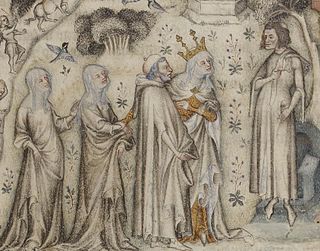
Guillaume de Machaut was a French composer and poet who was the central figure of the ars nova style in late medieval music. His dominance of the genre is such that modern musicologists use his death to separate the ars nova from the subsequent ars subtilior movement. Regarded as the most significant French composer and poet of the 14th century, he is often seen as the century's leading European composer.
Poetry took numerous forms in medieval Europe, for example, lyric and epic poetry. The troubadours, trouvères, and the minnesänger are known for composing their lyric poetry about courtly love usually accompanied by an instrument.

"The Love Song of J. Alfred Prufrock" is the first professionally published poem by American-born British poet T. S. Eliot (1888–1965). The poem relates the varying thoughts of its title character in a stream of consciousness. Eliot began writing the poem in February 1910, and it was first published in the June 1915 issue of Poetry: A Magazine of Verse at the instigation of fellow American expatriate Ezra Pound. It was later printed as part of a twelve-poem chapbook entitled Prufrock and Other Observations in 1917. At the time of its publication, the poem was considered outlandish, but the poem is now seen as heralding a paradigmatic shift in poetry from late 19th-century Romanticism and Georgian lyrics to Modernism.
In literary criticism, close reading is the careful, sustained interpretation of a brief passage of a text. A close reading emphasizes the single and the particular over the general, via close attention to individual words, the syntax, the order in which the sentences unfold ideas, as well as formal structures.
New Criticism was a formalist movement in literary theory that dominated American literary criticism in the middle decades of the 20th century. It emphasized close reading, particularly of poetry, to discover how a work of literature functioned as a self-contained, self-referential aesthetic object. The movement derived its name from John Crowe Ransom's 1941 book The New Criticism.
The term Middle English literature refers to the literature written in the form of the English language known as Middle English, from the late 12th century until the 1470s. During this time the Chancery Standard, a form of London-based English, became widespread and the printing press regularized the language. Between the 1470s and the middle of the following century there was a transition to early Modern English. In literary terms, the characteristics of the literary works written did not change radically until the effects of the Renaissance and Reformed Christianity became more apparent in the reign of King Henry VIII. There are three main categories of Middle English literature, religious, courtly love, and Arthurian, though much of Geoffrey Chaucer's work stands outside these. Among the many religious works are those in the Katherine Group and the writings of Julian of Norwich and Richard Rolle.
Middle English lyric a genre of English literature, is characterized by its brevity and emotional expression. Conventionally, the lyric expresses "a moment," usually spoken or performed in the first person. Although some lyrics have narratives, the plots are usually simple to emphasize an occasional, common experience. Even though lyrics appear individual and personal, they are not "original"; instead, lyrics express a common state of mind. Those states of mind are wide in range. Some deal with religious topics pertaining to Jesus or the Virgin Mary, focusing on Christ's sacrifice and salvation, or Mary's roles as a mother and intercessor. Other religious topics focus on Adam and the Fall, or the necessity of faith. Others are secular, focusing on ale, women, and the simple joys of life. Some are sarcastic, satiric, humorous, or even crude.
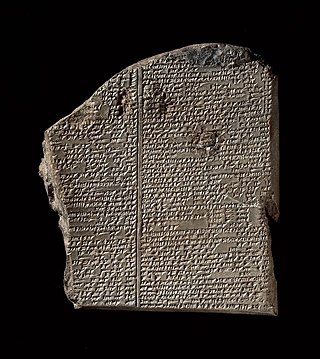
Poetry as an oral art form likely predates written text. The earliest poetry is believed to have been recited or sung, employed as a way of remembering oral history, genealogy, and law. Poetry is often closely related to musical traditions, and the earliest poetry exists in the form of hymns, and other types of song such as chants. As such, poetry is often a verbal art. Many of the poems surviving from the ancient world are recorded prayers, or stories about religious subject matter, but they also include historical accounts, instructions for everyday activities, love songs, and fiction.

Le Rime are a group of lyric poems by Dante Alighieri written throughout his life and based on the poet's varied existential and stylistic experiences. They were not designed as a collection by Dante himself, but were collected and ordered later by modern critics.
Sacred and Profane, Op. 91, is a collection of 'Eight Medieval Lyrics' for unaccompanied voices in five parts (SSATB) composed by Benjamin Britten in 1975.
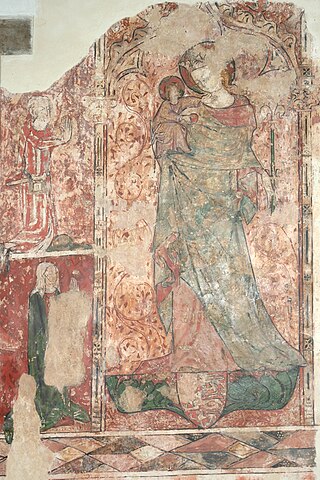
"Lullay, mine liking" is a Middle English lyric poem or carol of the 15th century which frames a narrative describing an encounter of the Nativity with a song sung by the Virgin Mary to the infant Christ. The refrain is an early example of an English lullaby; the term "lullaby" is thought to originate with the "lu lu" or "la la" sound made by mothers or nurses to calm children, and "by" or "bye bye", another lulling sound.
The Index of Middle English Verse (IMEV) is a bibliographic index of poetry in Middle English. Its first print publication, in 1943, was an extension of Carleton Brown's Register of Middle English Religious & Didactic Verse, augmented by the inclusion of secular verse. This edition, edited by Brown and Rossell Hope Robbins, contained entries for over 4,000 Middle English poems in more than 2,000 manuscripts. In 1965 the index was supplemented by Robbins and John L. Cutler. A digital edition, DIMEV, was launched in 2013.
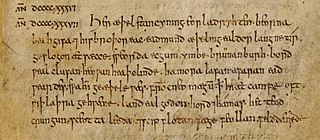
The "Battle of Brunanburh" is an Old English poem. It is preserved in the Anglo-Saxon Chronicle, a historical record of events in Anglo-Saxon England which was kept from the late ninth to the mid-twelfth century. The poem records the Battle of Brunanburh, a battle fought in 937 between an English army and a combined army of Scots, Vikings, and Britons. The battle resulted in an English victory, celebrated by the poem in style and language like that of traditional Old English battle poetry. The poem is notable because of those traditional elements and has been praised for its authentic tone, but it is also remarkable for its fiercely nationalistic tone, which documents the development of a unified England ruled by the House of Wessex.
"Maiden in the mor lay" or "The Maid of the Moor" is a Middle English lyric of the early 14th century, set to a melody which is now lost. The literary historian Richard L. Greene called it "one of the most haunting lyrics of all the Middle Ages", and Edith Sitwell thought it "a miracle of poetry". It is a notoriously enigmatic poem, perhaps devotional, perhaps secular, which depicts a maiden in the wilderness who lives on flowers and spring-water. Critics are divided in their interpretation of her: she may be the Virgin Mary, Mary Magdalene, a water-sprite, or an ordinary human girl. The 14th-century bishop Richard de Ledrede's dissatisfaction with this song led to an alternative lyric for it being written, a Latin religious poem, Peperit virgo.

"Alysoun" or "Alison", also known as "Bytuene Mersh ant Averil", is a late-13th or early-14th century poem in Middle English dealing with the themes of love and springtime through images familiar from other medieval poems. It forms part of the collection known as the Harley Lyrics, and exemplifies its best qualities. There may once have been music for this poem, but if so it no longer survives. "Alysoun" was included in The Oxford Book of English Verse, The Norton Anthology of English Literature, and The Longman Anthology of British Literature. It has been called one of the best lyrics in the language.
"Lenten ys come with love to toune", also known as "Spring", is an anonymous late-13th or early-14th century Middle English lyric poem which describes the burgeoning of nature as spring arrives, and contrasts it with the sexual frustration of the poet. It forms part of the collection known as the Harley Lyrics. Possibly the most famous of the Middle English lyrics, it has been called one of the best lyrics in the language, and "a lover's description of spring, richer and more fragrant in detail than any other of its period." No original music for this poem survives, but it has been set to music by Benjamin Britten, Alan Rawsthorne and others. It was included in The Oxford Book of English Verse.
"Ich am of Irlaunde", sometimes known as "The Irish Dancer", is a short anonymous Middle English dance-song, possibly fragmentary, dating from the early 14th century, in which an Irish woman issues an invitation to come and daunce wit me in Irlaunde. The original music for this song is now lost. It is historically important as being the earliest documented reference to Irish dance. "Ich am of Irlaunde" is well-known as the source of W. B. Yeats's poem "I Am of Ireland", and it was itself included in The Oxford Book of English Verse, The Norton Anthology of English Literature and The Longman Anthology of British Literature.
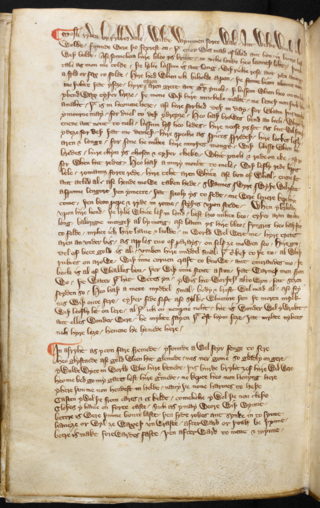
"Most I ryden by Rybbesdale", also titled "The Fair Maid of Ribblesdale", is an anonymous late-13th or early-14th century Middle English lyric poem. The text forms part of the collection known as the Harley Lyrics.
References
- ↑ Moser, Thomas C. Jr. (1987). "'And I Mon Waxe Wod': The Middle English 'Foweles in the Frith'". PMLA. 102 (3): 326–337. doi:10.2307/462480. JSTOR 462480. S2CID 163525837.
- ↑ Osberg, Richard H. (1981). "A Hand-List of Short Alliterating Metrical Poems in Middle English". The Journal of English and Germanic Philology . 80 (3): 313–326. JSTOR 27708833.
- ↑ Moser 326.
- ↑ Moser 326.
- ↑ Wimsatt, James I. (1974). "Reviewed Work(s): The Art of the Middle English Lyric: Essays in Criticism by Edmund Reiss". Speculum . 49 (2): 369–371. doi:10.2307/2856075. JSTOR 2856075.
- ↑ Huber, John (1973). "Reviewed Work(s): The Art of the Middle English Lyric: Essays in Criticism by Edmund Reiss". Notre Dame English Journal . 9 (1): 34–35. JSTOR 42748868.
- ↑ Davies, R. T. (1977). "Reviewed Work(s): Middle English Lyrics: Authoritative Texts, Critical and Historical Backgrounds, Perspectives on Six Poems by Maxwell S. Luria and Richard L. Hoffman". The Yearbook of English Studies . 7: 196–198. doi:10.2307/3507286. JSTOR 3507286.
- ↑ Moser 334, and 336 n.20.
- ↑ Reiss, Edmund (1966). "A Critical Approach to the Middle English Lyric". College English . 27 (5): 373–379. doi:10.2307/373258. JSTOR 373258.
- ↑ Davies, R. T. (1974). "Reviewed Work(s): The Art of the Middle English Lyric: Essays in Criticism by Edmund Reiss; Image and Abstraction: Six Middle English Religious Lyrics by William Elford Rogers". The Yearbook of English Studies . 4: 246–249. doi:10.2307/3506703. JSTOR 3506703.
- ↑ Moser 328-33.
- ↑ Moser 327-28.
- ↑ Lundeen, Stephanie Thompson (2009). "The Earliest Middle English Interludes". Comparative Drama . 43 (3): 379–400. doi:10.1353/cdr.0.0069. JSTOR 23038098.
- ↑ Evans, Peter (1978). "Reviewed Work(s): Sacred and Profane: Eight Medieval Lyrics, Op. 91, for Unaccompanied Voices by Benjamin Britten; Four Motets, Op. 89, for Unaccompanied Voices by John Joubert". Music & Letters . 59 (2): 237–238. doi:10.1093/ml/59.2.237. JSTOR 734156.